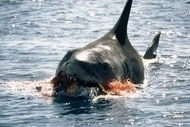Create a free profile to get unlimited access to exclusive videos, sweepstakes, and more!
Great White Sharks Have a Mysterious Second Life in the Ocean's Twilight Zone
What are they doing down there?

No monster put to film has ever been more terrifying than the imaginings of the human mind. It’s why filmmakers often keep their creatures off camera, tucked away in shadows, seen fleetingly. It’s also one of the reasons Jaws worked so well. Of course, you know what a Great White looks like, but the obscuring force of water meant that it was almost always unseen, lurking just out of view. It could be anywhere at any time, and that is terrifying.
The only thing scarier than seeing a shark in the water is not being able to see it and now scientists have learned that Great Whites and other predatory fish regularly hang out in the darkest parts of the deep. Great Whites mostly frequent shallow waters along coastlines in the temperate parts of the world, but a new study published in the Proceedings of the National Academy of Sciences finds that they frequently dive to incredible depths for reasons unknown.
Great Whites Dive Deep for Mysterious Reasons
Researchers tracked 12 species of oceanic predatory fish including white sharks, tiger sharks, whale sharks, billfish, tuna, and swordfish. Each of the animals, 344 in total, were tagged and their movements tracked by satellite. All told, scientists gathered nearly 47,000 cumulative days of data, an average of 136 per animal, which they compared against sonar data of the wider ecosystem.
RELATED: Sharks Are Older Than Trees, the North Star & Much More
The team found that all 12 species regularly plunged into the ocean’s mesopelagic zone, also known as the twilight zone, a water layer between 200 and 1,000 meters (656 and 3,280 feet) and the midnight zone, a water layer between 1,000 and 3,000 meters (3,280 and 9,800 feet) down. Their initial hypothesis was that large predators were chasing prey animals in what’s known as the Deep Scattering Layer. The DSL is so named because of the way it was discovered. When scientists first devised sonar and started probing the deep, the signals often bounced off a mysterious moving seafloor. They later realized it wasn’t the ocean floor, but a layer of fish, crustaceans, and other animals which live suspended in the water column. During the day they hang out in the deep, only emerging into shallower waters at night in a process known as Diel Vertical Migration.
When scientists compared the diving data to sonar measurements of the DSL, they found that many predators were indeed following prey as they fluttered up and down in the water, following the dark. But some of the dives were anomalous and much, much deeper. "There's good evidence for some species/situations in which diving deep is clearly for foraging. So that supported our expectation. However, we also find several cases where we can pretty definitively say the use of the deep ocean is not for feeding — or if it is it represents a totally different kind of predator-prey interaction or mysterious prey resource, said lead author Camrin Braun, via Live Science.
RELATED: Half-Eaten Great White Shark Washes Ashore in Australia
White sharks were tracked diving as deep as 1,128 meters (3,700 feet) while whale sharks and swordfish were tracked diving as deep as 1,912 meters (6,300 feet) and 2,000 meters (6,500 feet) respectively. It’s worth noting that while all species in the study were fish, many of them are distantly related and have entirely different evolutionary strategies. It’s unclear precisely why these predators are diving so deep – researchers suggest it may be a way of avoiding other predators or assisting with navigation – but it means traversing darker, colder, and higher-pressure waters, so they must have a good reason.
It’s possible that the initial hypothesis (diving for food) is correct for all 12 species and these outlier dives are in pursuit of some unknown food source. In other words, there may be an as yet unknown mass of fish and other animals hiding out in the deep. If that turns out to be true, it could open up a figurative gold rush for an untapped fishy vein. Researchers urge caution if that turns out to be the case.
“We're finding that the mesopelagic is providing an important support for other parts of the ocean. If we start to exploit these mesopelagic ecosystems before we know how they work, there's a really big risk of causing damage that is not easily reversible,” said Alice Della Penna, co-author at the University of Aukland, in a statement.
We don’t know what the sharks and the swordfish are doing down there but given our track record of exploiting every environment we ever set eyes on, maybe it’s better if we leave them to it.
There are plenty of sharks to play with on screen. Catch the summer horror classic, Jaws, available from Universal Pictures.




























